Impact of Low-E Window Films on Energy Consumption and CO2 Emissions of an Existing UK Hotel Building
Abstract
1. Introduction
2. Materials and Methods
3. Results
3.1. Validating the Simulation Results Against the Actual Data
3.1.1. Baseline Model Energy Simulation
3.1.2. Actual Annual Consumption
3.1.3. Choosing the Representative Data
3.2. Model with Window Films
- Baseline model: Hotel building in its existing state.
- Model with Thinsulate film: Model with Thinsulate film applied as a retrofitting measure on the internal surface of the inner windowpane.
- Model with Low-E double glazed unit (DGU): Model with a newly installed Low-E coated double glazed window unit.
- The reduction in total energy consumption is 4% for the model with Low-E DGU, and 2.7% for the model with Thinsulate, compared to the baseline model.
- Heating and cooling consumptions are both reduced in the retrofitted models. Therefore, in this aspect, Low-E films can demonstrate a better performance (although not significantly) compared to sun control films.
- The maximum reductions in different end use consumptions occur in auxiliary consumption, 14.9% for the model with Thinsulate and 16.7% for the model with Low-E DGU, which is due to a reduced usage of fans and pumps, as both heating and cooling energy consumptions are decreased.
- The main difference between the two retrofitted models comes with their impact on reducing heating energy consumptions. The 17% reduction in heating energy consumption achieved in the model with Low-E DGU outweighs the 3% reduction received in the model with Thinsulate. This is consistent with the literature, where it states the maximum function of Low-E glazing/films is achieved when they are applied on the external layer. The two models show similar reductions in cooling energy consumption, around 20%.
- The Low-E coating (regardless of its position) reduces the light transmittance—in the case of this study, the reduction is 20%. However, the lighting energy consumption is unaffected, which can be justified as below:
- The NCM profile for hotels considers areas such as guestrooms to be vacant during the day (from 09:00 to 21:00) and occupied in the late afternoon/evening when there is already the need for using artificial lighting. Therefore, a reduced light transmittance will not increase the need for lighting in the guestrooms.
- Areas with constant use such as the restaurant, lobby, and gym keep their lights on during their active time as part of the hospitality policy. Therefore, a reduced light transmittance will not increase the need for lighting in these areas, as well.
- Electricity: 11.53 Pence/kWh
- Natural gas: 2.371 Pence/kWh
4. Discussion
5. Conclusions
Author Contributions
Funding
Conflicts of Interest
References
- Committee on Climate Change. Meeting Carbon Budgets—Ensuring a Low-Carbon Recovery: 2nd Progress Report to Parliament Committee on Climate Change; Committee on Climate Change: London, UK, 2010. [Google Scholar]
- Boßmann, T.; Eichhammer, W.; Elsland, R. Policy Report; Contribution of energy efficiency measures to climate protection within the European Union until 2050; Federal Ministry for the Environment, Nature Conservation and Nuclear Safety (BMU): Berlin, Germany; Fraunhofer Institute for Systems and Innovation Research ISI: Karlsruhe, Germany, 2012.
- Ralegaonkar, R.V.; Gupta, R. Review of intelligent building construction: A passive solar architecture approach. Renew. Sustain. Energy Rev. 2010, 14, 2238–2242. [Google Scholar] [CrossRef]
- Mirrahimi, S.; Mohamed, M.F.; Haw, L.C.; Ibrahim, N.L.N.; Yusoff, W.F.M.; Aflaki, A. The effect of building envelope on the thermal comfort and energy saving for high-rise buildings in hot-humid climate. Renew. Sustain. Energy Rev. 2016, 53, 1508–1519. [Google Scholar] [CrossRef]
- Jelle, B.P.; Hynd, A.; Gustavsen, A.; Arasteh, D.; Goudey, H.; Hart, R. Fenestration of today and tomorrow: A state-of-the-art review and future research opportunities. Sol. Energy Mater. Sol. Cells 2012, 96, 1–28. [Google Scholar] [CrossRef]
- Urbikain, M.K.; Sala, J.M. Analysis of different models to estimate energy savings related to windows in residential buildings. Energy Build. 2009, 41, 687–695. [Google Scholar] [CrossRef]
- Cuce, E.; Riffat, S.B. A state-of-the-art review on innovative glazing technologies. Renew. Sustain. Energy Rev. 2015, 41, 695–714. [Google Scholar] [CrossRef]
- Djamel, Z.; Noureddine, Z. The Impact of Window Configuration on the Overall Building Energy Consumption under Specific Climate Conditions. Energy Procedia 2017, 115, 162–172. [Google Scholar] [CrossRef]
- The Building Regulations 2010. Approved Document L2A: Conservation of Fuel and Power in New Buildings Other than Dwellings; RIBA Publishing: London, UK, 2010. [Google Scholar]
- Jaber, S.; Ajib, S. Thermal and economic windows design for different climate zones. Energy Build. 2011, 43, 3208–3215. [Google Scholar] [CrossRef]
- Hassouneh, K.; Alshboul, A.; Al-Salaymeh, A. Influence of windows on the energy balance of apartment buildings in Amman. Energy Convers. Manag. 2010, 51, 1583–1591. [Google Scholar] [CrossRef]
- Li, C.; Tan, J.; Chow, T.T.; Qiu, Z. Experimental and theoretical study on the effect of window films on building energy consumption. Energy Build. 2015, 102, 129–138. [Google Scholar] [CrossRef]
- Bahadori-Jahromi, A.; Rotimi, A.; Mylona, A.; Godfrey, P.; Cook, D. Impact of window films on the overall energy consumption of existing UK hotel buildings. Sustainability 2017, 9. [Google Scholar] [CrossRef]
- Moretti, E.; Belloni, E. Evaluation of energy, thermal, and daylighting performance of solar control films for a case study in moderate climate. Build. Environ. 2015, 94, 183–195. [Google Scholar] [CrossRef]
- Mohelníková, J. Window Glass Coatings. In Energy Efficiency and Renewable Energy Through Nanotechnology; Zang, L., Ed.; Springer: London, UK, 2011; pp. 913–934. ISBN 978-0-85729-638-2. [Google Scholar]
- Yin, R.; Xu, P.; Shen, P. Case study: Energy savings from solar window film in two commercial buildings in Shanghai. Energy Build. 2012, 45, 132–140. [Google Scholar] [CrossRef]
- Rezaei, S.D.; Shannigrahi, S.; Ramakrishna, S. A review of conventional, advanced, and smart glazing technologies and materials for improving indoor environment. Sol. Energy Mater. Sol. Cells 2017, 159, 26–51. [Google Scholar] [CrossRef]
- Costanzo, V.; Evola, G.; Marletta, L. Thermal and visual performance of real and theoretical thermochromic glazing solutions for office buildings. Sol. Energy Mater. Sol. Cells 2016, 149, 110–120. [Google Scholar] [CrossRef]
- Sweitzer, G.; Arasteh, D.; Selkowitz, S. Effects of low-emissivity glazings on energy use patterns in nonresidential daylighted buildings. ASHRAE Trans. 1987, 93, 1–15. [Google Scholar]
- Sadrzadehrafiei, S.; Sopian, K.; Lim, C. Application of Advanced Glazing to Mid- Rise Office Buildings in Malaysia. In Proceedings of the 9th WSEAS International Conference on Environment, Ecosystems and Development, Montreux, Switzerland, 2011; pp. 197–201. [Google Scholar]
- Collins, R.E.; Simko, T.M. Current status of the science and technology of vacuum glazing. Sol. Energy 1998, 62, 189–213. [Google Scholar] [CrossRef]
- Fang, Y.; Arya, F.; Hyde, T.J.; Hewitt, N. A Novel Building Component Hybrid Vacuum Glazing—A Modelling and Experimental Validation. ASHRAE Trans. 2013, 119, 430–441. [Google Scholar]
- Karlsson, J.; Roos, A. Annual energy window performance vs. glazing thermal emittance—The relevance of very low emittance values. Thin Solid Films 2001, 392, 345–348. [Google Scholar] [CrossRef]
- Romagnoni, P.; Cappelletti, F.; Peron, F.; Toffoli, S. Analysis of energy performance of commercial buildings with different extension of glazed area. In Proceedings of the 5th International Conference on Sustainable Energy Technologies, Vicenza, Italy, 2006. [Google Scholar]
- Chow, T.-t.; Li, C.; Lin, Z. Innovative solar windows for cooling-demand climate. Sol. Energy Mater. Sol. Cells 2010, 94, 212–220. [Google Scholar] [CrossRef]
- Gorgolis, G.; Karamanis, D. Solar energy materials for glazing technologies. Sol. Energy Mater. Sol. Cells 2016, 144, 559–578. [Google Scholar] [CrossRef]
- Ye, H.; Meng, X.; Long, L.; Xu, B. The route to a perfect window. Renew. Energy 2013, 55, 448–455. [Google Scholar] [CrossRef]
- Wang, J.; Shi, D. Spectral selective and photothermal nano structured thin films for energy efficient windows. Appl. Energy 2017, 208, 83–96. [Google Scholar] [CrossRef]
- Sadineni, S.B.; Madala, S.; Boehm, R.F. Passive building energy savings: A review of building envelope components. Renew. Sustain. Energy Rev. 2011, 15, 3617–3631. [Google Scholar] [CrossRef]
- Amoako-attah, J.; B-jahromi, A. Impact of standard construction specification on thermal comfort in UK dwellings. Adv. Environ. Res. 2014, 3, 253–281. [Google Scholar] [CrossRef]
- Rotimi, A.; Bahadori-jahromi, A.; Mylona, A.; Godfrey, P.; Cook, D. Estimation and Validation of Energy Consumption in UK Existing Hotel Building Using Dynamic Simulation Software. Sustainability 2017, 9, 1391. [Google Scholar] [CrossRef]
- Eames, M.E.; Ramallo-gonzalez, A.P.; Wood, M.J. An update of the UK’s test reference year: The implications of a revised climate on building design. Build. Serv. Eng. Res. Technol. 2016, 316–333. [Google Scholar] [CrossRef]
- M Thinsulate Window Films Climate Control Series. Available online: https://www.3m.com/3M/en_US/company-us/all-3m-products/~/3M-Thinsulate-Window-Film-Climate-Control-Series-for-Residential/?N=5002385+3292123816&preselect=3293786499&rt=rud (accessed on 20 March 2019).
- Salem, R.; Bahadori-jahromi, A.; Mylona, A.; Godfrey, P.; Cook, D. Carbon Emissions and Evaluation of the Potential Energy, Carbon Emissions, and Financial Impacts from the Incorporation of CHP and CCHP systems in Existing UK Hotel Buildings. Energies 2018, 11, 1219. [Google Scholar] [CrossRef]
- Chartered Institution of Building Services Engineers (CIBSE). Energy Efficicency in Commercial Kitchens, CIBSE TM 50; Chartered Institution of Building Services Engineers: London, UK, 2009. [Google Scholar]
- Bohdanowicz, P.; Martinac, I. Determinants and benchmarking of resource consumption in hotels-Case study of Hilton International and Scandic in Europe. Energy Build. 2007, 39, 82–95. [Google Scholar] [CrossRef]
- Priyadarsini, R.; Xuchao, W.; Eang, L.S. A study on energy performance of hotel buildings in Singapore. Energy Build. 2009, 41, 1319–1324. [Google Scholar] [CrossRef]
- Chartered Institution of Building Services Engineers (CIBSE). Degree-Days: Theory and Application, TM41; Chartered Institution of Building Services Engineers: London, UK, 2006. [Google Scholar]
- MET Office UK Climate. Available online: https://www.metoffice.gov.uk/public/weather/climate (accessed on 8 June 2019).
- UK Government Gas and Electricity Prices in the Non-Domestic Sector. Available online: https://www.gov.uk/government/statistical-data-sets/gas-and-electricity-prices-in-the-non-domestic-sector (accessed on 27 March 2019).
- Chartered Institution of Building Services Engineers (CIBSE). Environmental design, CIBSE Guide A; Chartered Institution of Building Services Engineers: London, UK, 2015. [Google Scholar]


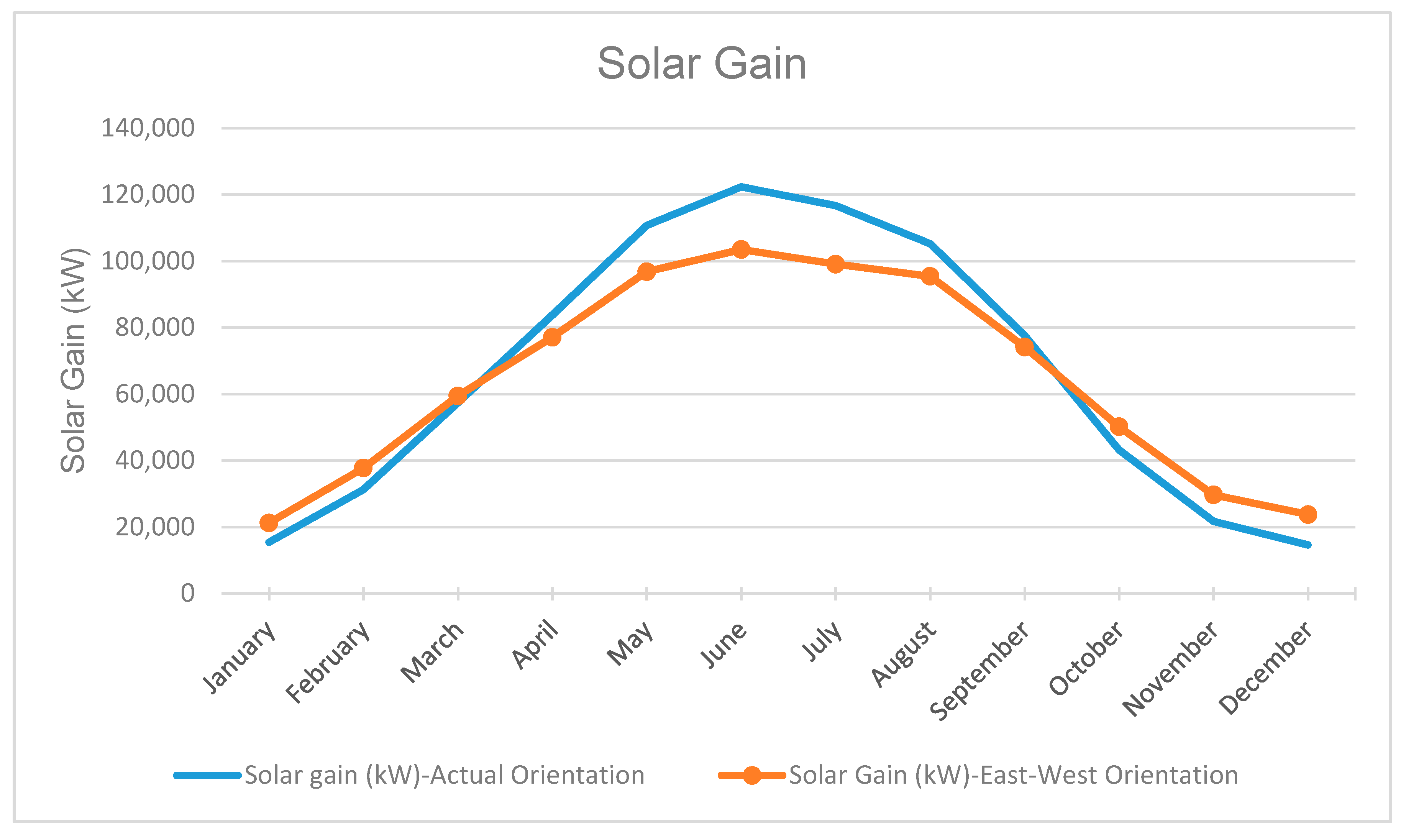
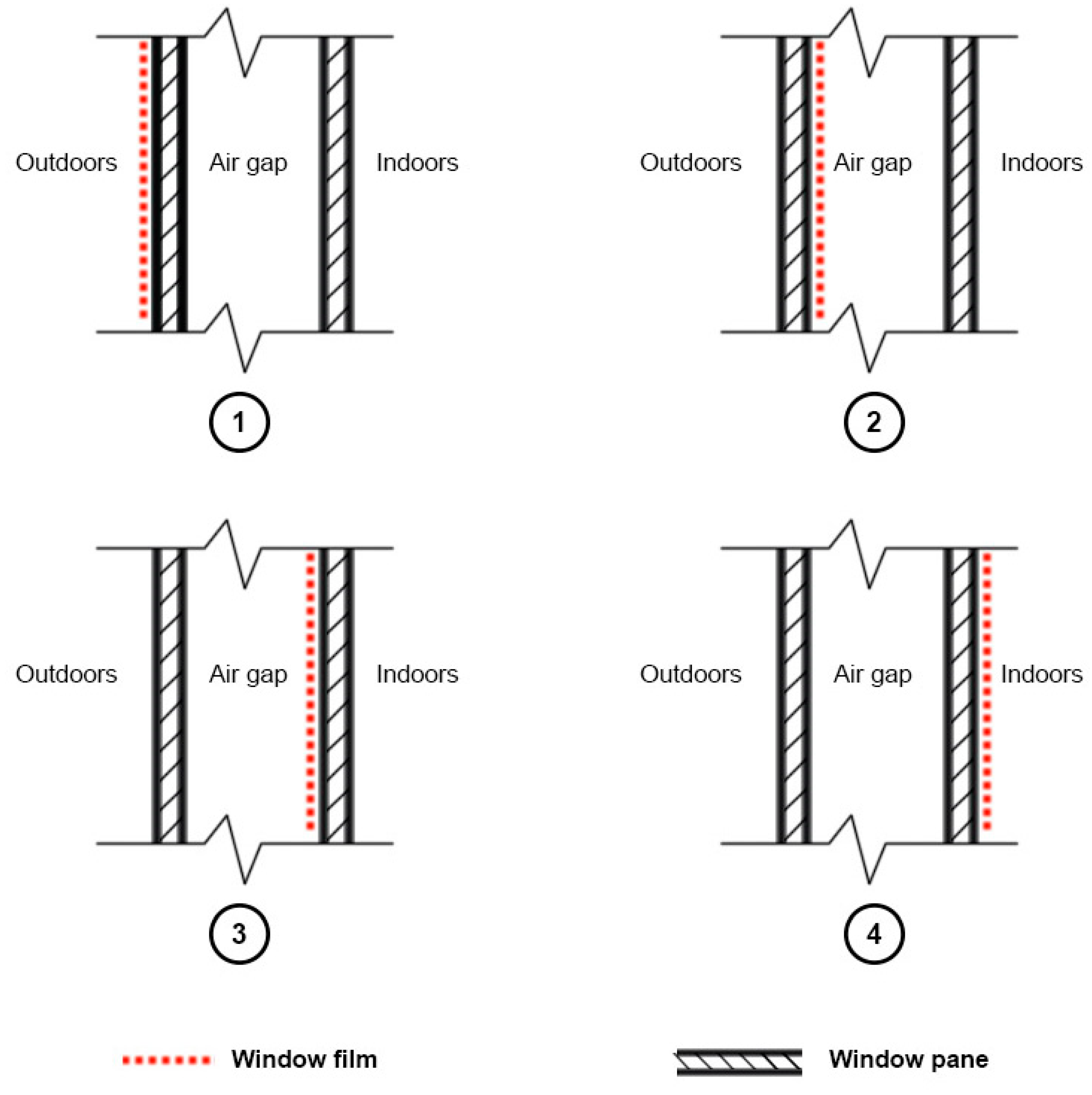


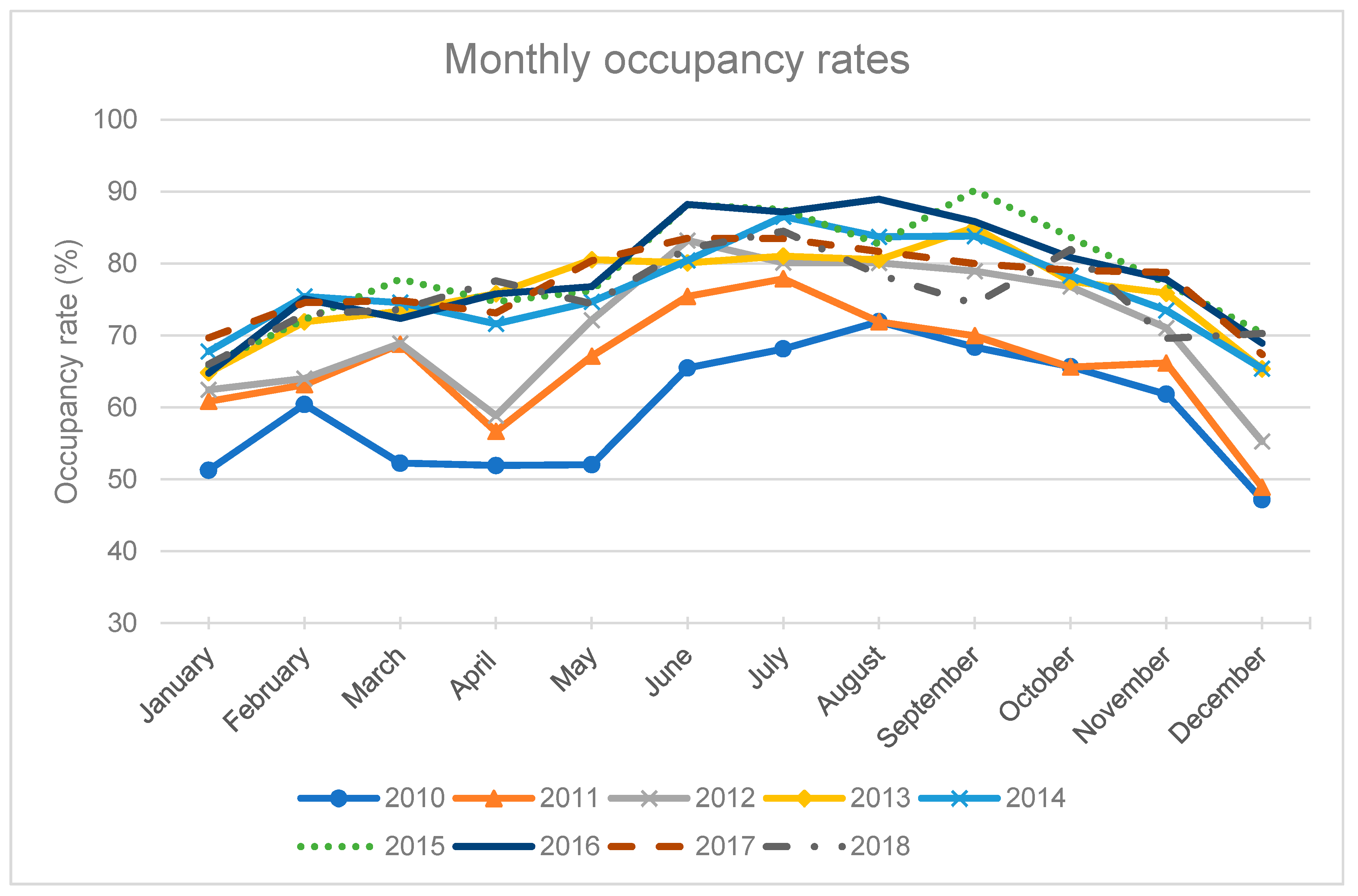


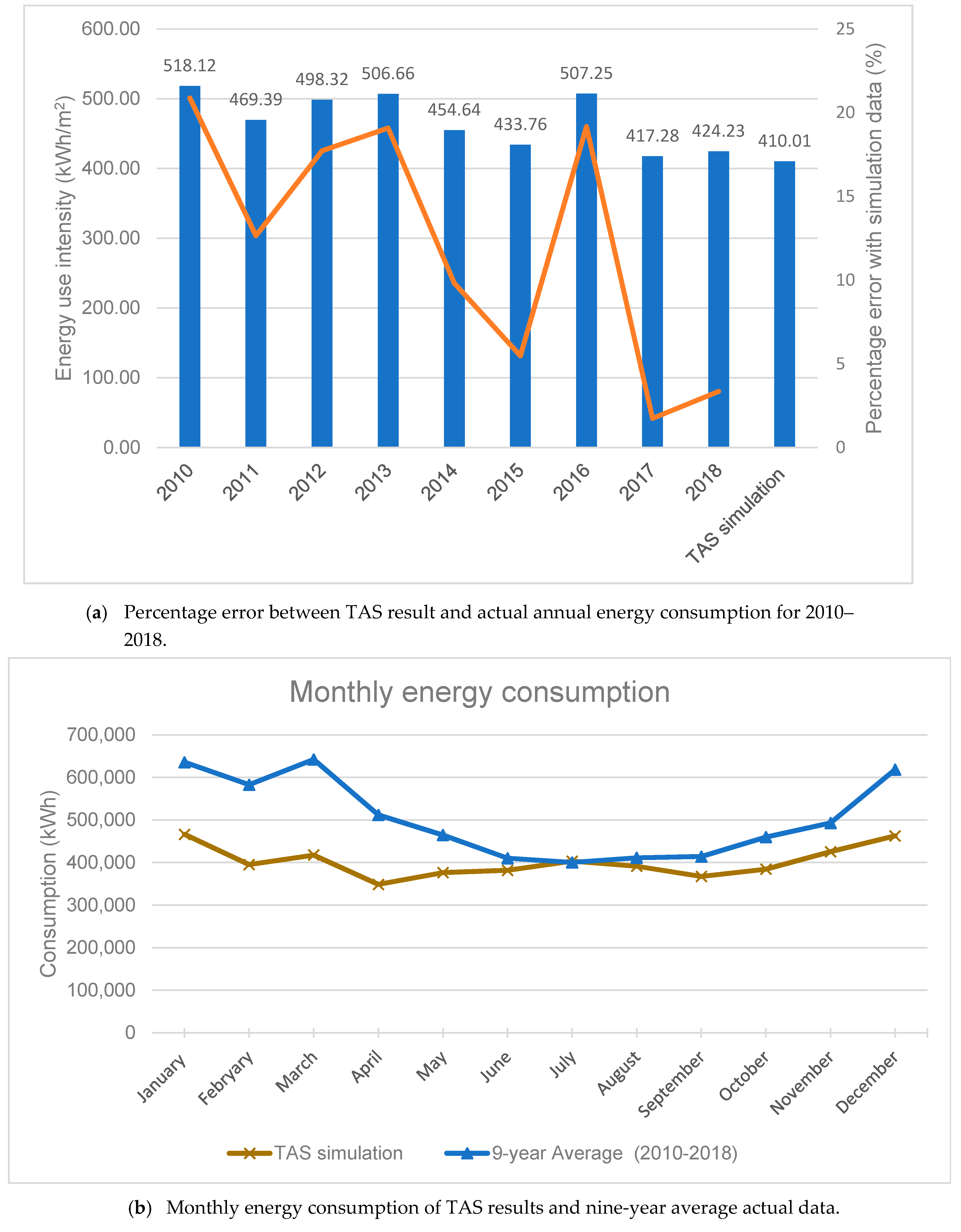

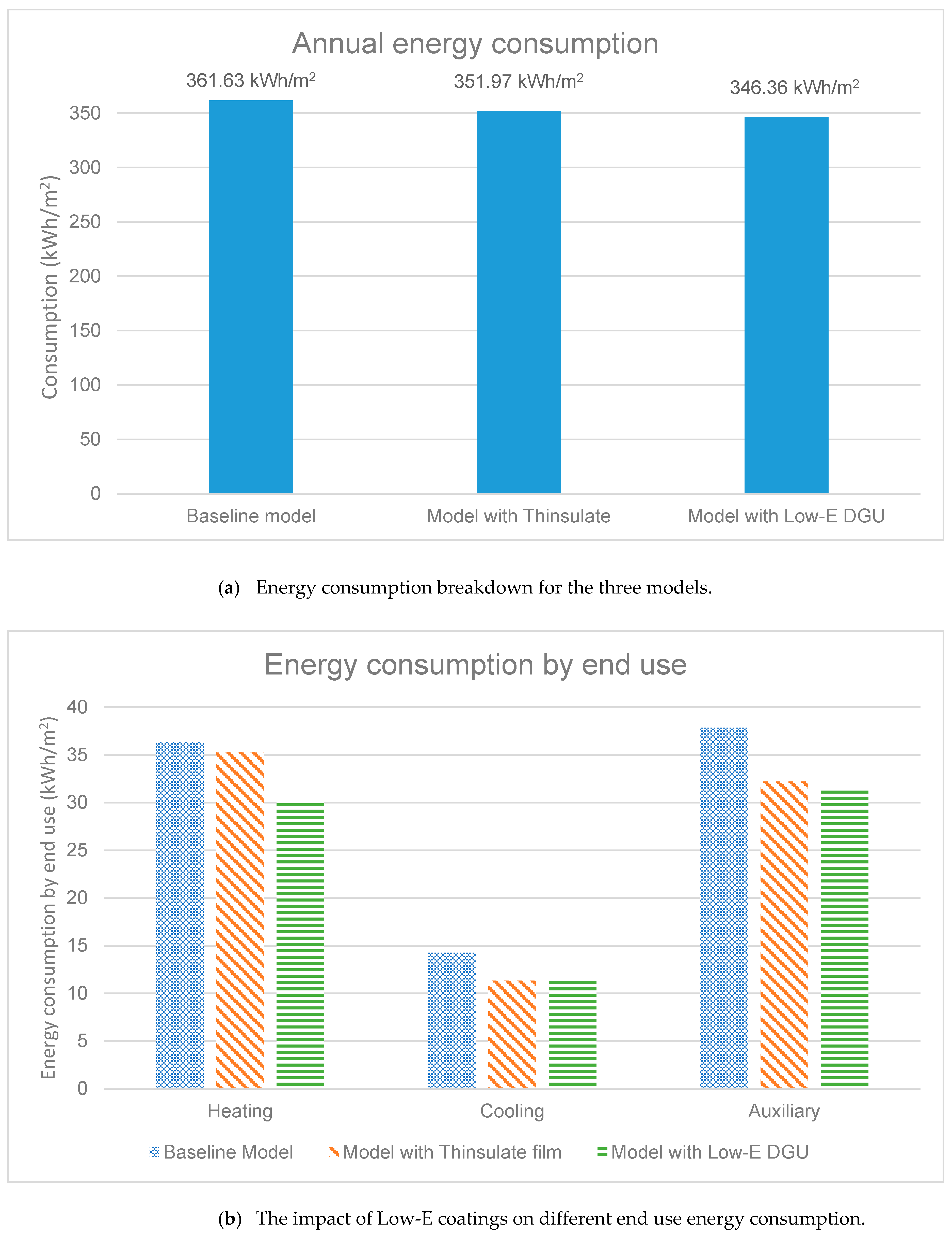







| Type of Window Film | Visible Light | G-Value | Light to Solar Gain (LSG) | UV Block | Heat Gain Reduction % | Heat Loss Reduction % | ||
|---|---|---|---|---|---|---|---|---|
| Reflected % (Interior) | Reflected % (Exterior) | Transmitted % | ||||||
| Thinsulate CC 75 | 12 | 16 | 74 | 0.53 | 1.4 | 99.9 | 35 | 40 |
| PR 70 EXT | 7 | 7 | 71 | 0.48 | 1.5 | 99.9 | 41 | - |
| PR 40 EXT | 5 | 6 | 42 | 0.39 | 1.6 | 99.9 | 53 | - |
| Type of Window Film | Visible Light | G-Value | Light to Solar Gain (LSG) | UV Block % | Heat Gain Reduction % | Heat Loss Reduction % | Emissivity | ||
|---|---|---|---|---|---|---|---|---|---|
| Reflected % (Interior) | Reflected % (Exterior) | Transmitted % | |||||||
| Thinsulate CC 75 | 17 | 21 | 66 | 0.51 | 1.3 | 99.9 | 27 | 40 | 0.15 |
| PR 70 EXT | 14 | 12 | 63 | 0.39 | 1.6 | 99.9 | 45 | - | 0.84 |
| PR 40 EXT | 13 | 7 | 37 | 0.29 | 1.3 | 99.9 | 59 | - | 0.84 |
| Number of Observations | Multiple R | R Squared | p-Value |
|---|---|---|---|
| 108 | 0.608 | 0.370 | <0.005 |
| Number of Observations | Multiple R | R Squared | p-Value |
|---|---|---|---|
| 108 | 0.775 | 0.600 | <0.005 |
| Measure Taken | Heating Energy Consumption % | Cooling Energy Consumption % | Total Energy Consumption % | CO2 Emissions from Gas % | CO2 Emissions from Electricity % | Total CO2 Emissions % | Gas Costs % | Electricity Costs % | Total Energy Costs % |
|---|---|---|---|---|---|---|---|---|---|
| Thinsulate Films | 3 | 20 | 2.7 | 0.5 | 6.8 | 4.1 | 0.5 | 6.8 | 5.1 |
| Low-E DGU | 16.8 | 19.8 | 4 | 2.7 | 7.2 | 5.3 | 2.7 | 7.2 | 6 |
| PR 70 EXT | −0.2 | 28 | 2.1 | −0.5 | 5 | 3 | N/A | 5 | 3 |
| PR 40 EXT | −1.3 | 32 | 1.9 | −1 | 6 | 3 | N/A | 6 | 3 |
© 2019 by the authors. Licensee MDPI, Basel, Switzerland. This article is an open access article distributed under the terms and conditions of the Creative Commons Attribution (CC BY) license (http://creativecommons.org/licenses/by/4.0/).
Share and Cite
Amirkhani, S.; Bahadori-Jahromi, A.; Mylona, A.; Godfrey, P.; Cook, D. Impact of Low-E Window Films on Energy Consumption and CO2 Emissions of an Existing UK Hotel Building. Sustainability 2019, 11, 4265. https://doi.org/10.3390/su11164265
Amirkhani S, Bahadori-Jahromi A, Mylona A, Godfrey P, Cook D. Impact of Low-E Window Films on Energy Consumption and CO2 Emissions of an Existing UK Hotel Building. Sustainability. 2019; 11(16):4265. https://doi.org/10.3390/su11164265
Chicago/Turabian StyleAmirkhani, Shiva, Ali Bahadori-Jahromi, Anastasia Mylona, Paulina Godfrey, and Darren Cook. 2019. "Impact of Low-E Window Films on Energy Consumption and CO2 Emissions of an Existing UK Hotel Building" Sustainability 11, no. 16: 4265. https://doi.org/10.3390/su11164265
APA StyleAmirkhani, S., Bahadori-Jahromi, A., Mylona, A., Godfrey, P., & Cook, D. (2019). Impact of Low-E Window Films on Energy Consumption and CO2 Emissions of an Existing UK Hotel Building. Sustainability, 11(16), 4265. https://doi.org/10.3390/su11164265






